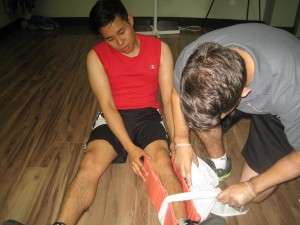Cardiopulmonary resuscitation is one of many lifesaving skills that a person should be responsible enough to have. Millions of people all over the world die each year because of cardiac conditions – with 500,000 of those deaths being Americans. CVDs (cardiovascular diseases) are the number one cause of deaths in the world and in most countries, including the United States. For something that is easily preventable with the correct lifestyle choices, it is baffling how so many people are diagnosed with it each year.
From cardiac disease to cardiac arrest

While CVDs are largely lifestyle based, there are cases wherein cardiac conditions are hereditary or caused by other non-modifiable risk factors. However, either way, if a cardiac condition is not managed adequately it can cause a heart attack and eventual cardiac arrest. The last two terms are different, though both are related to severe cardiac dysfunction. The term heart attack is a layman’s; the correct medical term is myocardial infarction – a condition where the blood supply to the heart stops, causing cardiac muscle damage and death.
There are two things that can happen after a person has a heart attack: (1) the heart can continue to beat (usually irregularly) or (2) stop completely. The second in the list is cardiac arrest. Whether a person experiences cardiac arrest in or outside of a hospital, the first thing rescuers do is give compressions. Chest compressions keep the heart beating and manually circulating blood in the body. In the hospital, other management techniques are used as well, such as administering cardiac medication, but compressions always take center stage.
CPR and first aid courses
Seattle CPR training courses have two parts – CPR/AED and first aid. Both CPR and first aid are included because most of the time cardiac arrest is accompanied by other emergencies, such as concussions, head injuries, and other similar conditions. It is important that a rescuer knows how to manage different kinds of emergencies, not just CPR.
We offer trainees different programs, primarily categorized into either basic or advanced training. Basic programs are short, usually single-session classes that last 4 hours. Advanced program courses are only for health care professionals, and are therefore quite long. They take two days to complete and can last as long as 16 hours.
- Basic CPR, AED, and first aid (public course)
- Basic CPR, AED, and first aid (health care providers)
- Basic Life Support for HCPs
- Pediatric Advanced Life Support (allied health professionals)
- Advanced Cardiac Life Support (allied health professionals)
All of the courses listed are certification courses. The certificates are only valid for 24 months and have to be renewed before they expire. We have re-certification courses for exactly that purpose, but they are only available for three of our training programs (the last three on the list). Re-certification courses are generally shorter than a full training course.
Visit the Seattle CPR website for a complete list of classes, schedules, and training fees.
